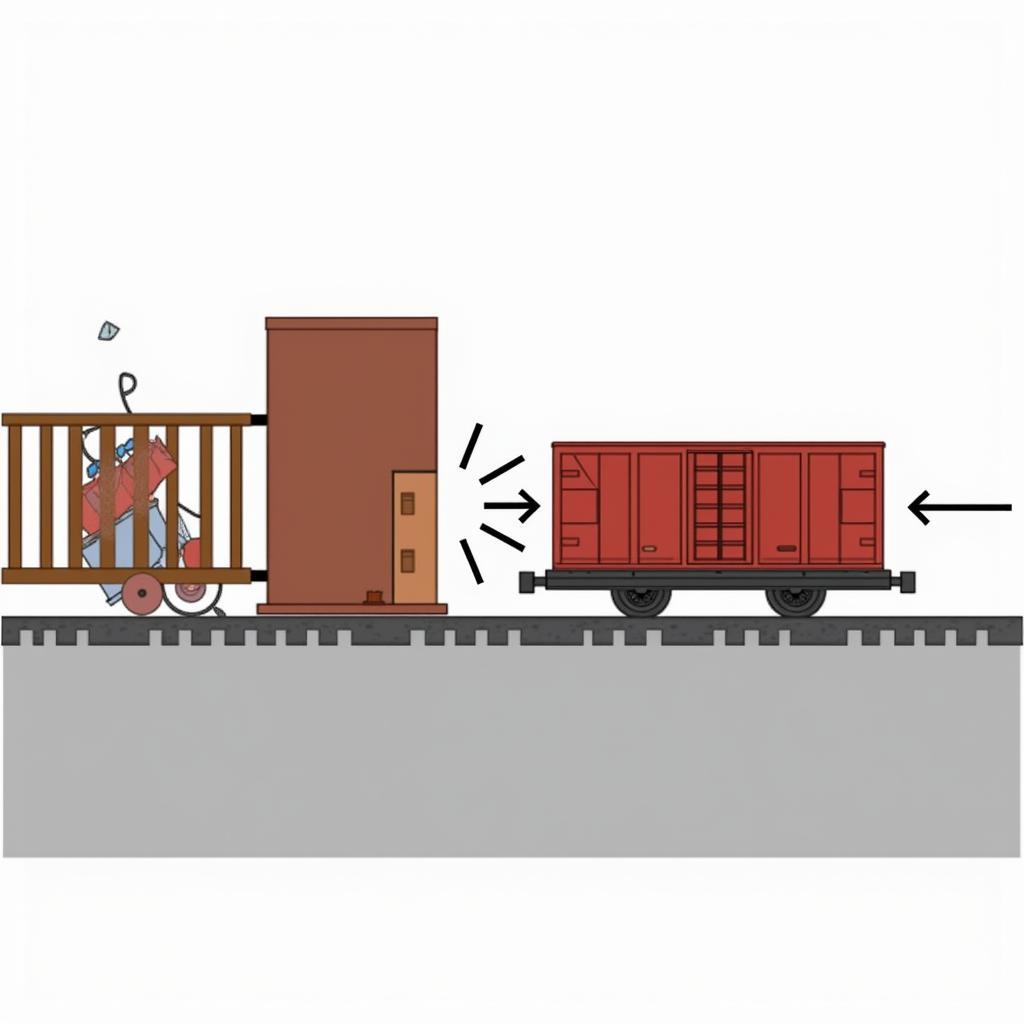Understanding box car physics, specifically momentum problems and their solutions, is crucial for anyone involved with vehicles, from everyday drivers to seasoned mechanics. Within the first few moments of a collision, the principles of momentum dictate the outcome. This article delves into the core concepts of momentum, common box car physics scenarios, and practical solutions for analyzing and addressing these problems.
What is Momentum in Box Car Physics?
Momentum, in the context of box car physics, refers to the quantity of motion an object possesses. It’s calculated by multiplying the object’s mass by its velocity. A heavier box car moving at a certain speed will have more momentum than a lighter box car moving at the same speed. This means a greater force is required to change its state of motion.
Common Box Car Physics Momentum Problems
Inelastic Collisions
Inelastic collisions are a common scenario in box car physics. In these situations, kinetic energy is not conserved, often leading to deformation and heat generation. Imagine two box cars coupling together after impact. Solving these problems involves understanding the principle of conservation of momentum: the total momentum before the collision equals the total momentum after the collision.
Elastic Collisions
In elastic collisions, both momentum and kinetic energy are conserved. While less common in real-world box car scenarios due to energy loss through friction and sound, understanding elastic collisions provides a valuable foundation for analyzing more complex situations. Consider a box car bouncing off another with minimal energy loss.
Collisions with Stationary Objects
Another common problem involves a moving box car colliding with a stationary object, like a barrier or another stationary car. Here, the momentum of the moving box car is transferred to the stationary object, potentially causing damage or displacement.
Solutions to Box Car Physics Momentum Problems
Applying the Conservation of Momentum Principle
The key to solving most box car physics momentum problems lies in applying the conservation of momentum principle. By setting the total momentum before the collision equal to the total momentum after the collision, we can determine unknown variables such as final velocities.
Considering Real-World Factors
While idealized physics problems often neglect factors like friction and air resistance, real-world applications require considering these forces. These factors can significantly influence the outcome of a collision. For instance, a box car rolling on a slightly inclined track will experience a change in momentum due to gravity.
Utilizing Momentum and Impulse
Impulse, the change in momentum, is a crucial concept for understanding the forces involved in collisions. A large force applied over a short time interval results in a significant change in momentum. This principle is crucial in designing safety features for box cars and other vehicles.
 Box Car Elastic Collision
Box Car Elastic Collision
Practical Applications in Automotive Repair
Understanding these principles has direct implications for automotive repair. Analyzing the damage from a collision can help determine the forces involved and identify potential hidden damage. This knowledge is crucial for accurate repairs and restoring the vehicle to its pre-accident condition.
“Understanding momentum is not just about theoretical physics,” says Dr. Emily Carter, a renowned automotive engineer. “It’s about understanding how forces interact in real-world collisions, which is essential for effective vehicle repair and design.”
Box Car Physics Momentum: Frequently Asked Questions
How do I calculate the momentum of a box car?
Multiply the box car’s mass by its velocity.
What’s the difference between elastic and inelastic collisions?
In elastic collisions, both momentum and kinetic energy are conserved. In inelastic collisions, only momentum is conserved.
Why is understanding momentum important for car repair?
Analyzing collision damage using momentum principles helps identify potential hidden damage and ensures accurate repairs.
What is impulse, and how does it relate to momentum?
Impulse is the change in momentum, representing the effect of a force applied over time.
How does friction affect momentum in box car physics?
Friction opposes motion and can reduce the momentum of a moving box car.
What role does gravity play in box car momentum on an inclined track?
Gravity can increase or decrease the momentum depending on whether the box car is moving uphill or downhill.
Where can I get more help with box car physics problems?
Contact Autotippro at +1 (641) 206-8880 or visit our office at 500 N St Mary’s St, San Antonio, TX 78205, United States, for expert assistance.
 Box Car Collision with Stationary Object
Box Car Collision with Stationary Object
In conclusion, understanding Box Car Physics Momentum Problems And Solutions is paramount for anyone working with vehicles. By grasping the fundamental principles of momentum, impulse, and energy conservation, you can analyze collision scenarios effectively and apply this knowledge to practical situations like vehicle repair and design. Remember, box car physics, especially the concept of momentum, is more than just theory – it’s the key to understanding the dynamics of real-world collisions and ensuring safe and effective vehicle operation. Contact AutoTipPro for further assistance with your automotive needs. We are here to help!




Leave a Reply